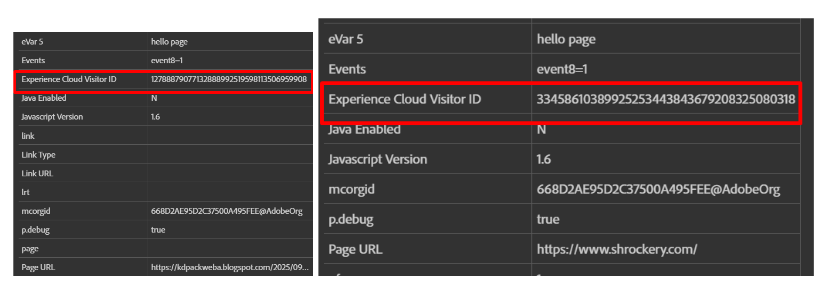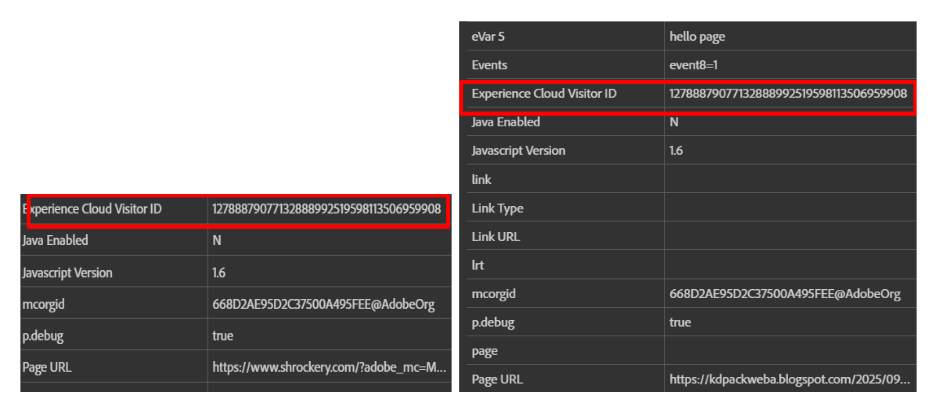Why Cross-Domain Tracking Is the Medicine Your Analytics Needs
A Real-World Problem
Imagine you’re trying to book a doctor’s appointment online.
You start on hospital.com, browsing doctors and services. When you’re ready, you click “Book Appointment”, which takes you to bookings.healthcare.com.
From your perspective, it’s one smooth journey. But to analytics?
Visit on hospital.com = Visitor A
Appointment on bookings.healthcare.com = Visitor B
The session breaks apart. Reports indicate that people are exploring doctors, but are not booking appointments. Conversion funnels look incomplete, and marketing campaigns don’t get proper credit.
That’s the headache organizations face without cross-domain tracking.
The Cure: Cross-Domain Tracking
Cross-domain tracking ensures the same Experience Cloud ID (ECID) follows the user across domains. Instead of splitting, the journey is stitched together:
Visitor browses services → books a slot → confirms — all seen as one person, one journey.
Why Healthcare (and Everyone Else) Needs It?
- Accurate journeys → see the real funnel from browsing services to booking care.
- Proper attribution → marketing efforts (Google Ads, campaigns) get the credit they deserve.
- Reliable visitor counts and sessions → stop double-counting people and their visits who cross properties.
- Future-proofing → as browsers phase out 3rd-party cookies(demdex in this case), explicit stitching is the only reliable way to connect domains.
How It Works
- ECID is created on the first site
- When the patient visits hospital.com, AppMeasurement creates and stores an ECID in the cookie (AMCV_…).
- Historically, Adobe also tied this to a demdex cookie (3rd-party). But with Safari, Firefox, and Chrome restricting 3rd-party cookies, this fallback can no longer be trusted.
- ECID travels in the URL
- When the patient clicks “Book Appointment,” AppMeasurement appends the ECID to the link as a query parameter (adobe_mc=…MCMID=12345).
- ECID is saved on the booking site
- On bookings.healthcare.com, the parameter(MID from the URL) is read, and the same ECID is set in the cookie.
- Both domains now see the patient as the same person.
Prerequisites Before You Enable It
- Both domains must share the same Adobe Org ID.
- Same report suite or 1 Global Report Suite and 2 separate Report suites for each domain
- Consistent trackingServer / trackingServerSecure configuration.
- If by default, using Adobe servers, both domains point to Adobe edge endpoints.
- If using CNAME, ensure all domains point to the same endpoint.
- ECID extension installed, enable allowLinker(overwriteCrossDomainMCIDAndAID to TRUE) so ECID gets carried in query strings.
- Configure linkInternalFilters (both domains, Domain A and Domain B).
Why Internal Filters Are So Important
It’s not enough to pass ECIDs around.
- Without linkInternalFilters, analytics incorrectly identifies cross-domain clicks as exits or external referrals.
- This means:
- Funnels break (session looks like it ended).
- Referrals get inflated (your own site shows up as “referring traffic”).
- Conversions appear disconnected.
With proper filters, Adobe knows your domains are part of the same family — making ECID stitching reliable and keeping your reports clean.
Now, let’s review the steps to implement Cross-Domain Tracking.
Before diving into the steps, let’s see what scenarios and examples we have here.
- We have created a Test button on the Blogger website (which is acting as Domain A), pointing to Domain B.
- The same Report Suite is configured to collect data, and each domain is configured with its own launch property, but under the same org.
- Using Visitor.appendVisitorIDsTo( *url*). Method to enable cross-domain tracking.
Step 1 – Install the Adobe Analytics extension and ECID extension in both Launch Properties.
Step 2 – In the launch property of Domain A, add this code(modify it as per your configuration), in the Adobe Analytics extension custom code.
This code will decorate all link that contains the href of your Domain B with query parameters (adobe_mc=…MCMID=12345) on click of that anchor link.
var adbeDomains = ["DomainA.com", "DomainB"];
var visitor = Visitor.getInstance("***********************@AdobeOrg", {
trackingServer: "***.adobe.com",
trackingServerSecure: "***.adobe.com",
marketingCloudServer: "***.adobe.com",
marketingCloudServerSecure: "***.adobe.com"
});
adbeDomains.forEach(function(domain) {
var domainRegex = RegExp(domain);
if (!domainRegex.test(location.hostname)) {
hrefSelector = '[href*="' + domain + '"]';
document.querySelectorAll(hrefSelector).forEach(function(href) {
href.addEventListener('mousedown', function(event) {
var destinationURLWithVisitorIDs = visitor.appendVisitorIDsTo(event.currentTarget.href)
event.currentTarget.href = destinationURLWithVisitorIDs.replace(/MCAID%3D.*%7CMCORGID/, 'MCAID%3D%7CMCORGID');
});
}); } });
Step 3 – In Launch Property of Website B, go to ECID extension, and under variable, enable overwriteCrossDomainMCIDAndAID to TRUE. This will read the MID stitched in the URL of website B and overwrite the cookies.

Adobe launch – ECID Extension allows Linker option
Step 4 – Add both URLs to the internal filters list, so that both domains can be treated as internal links and not external.
Step 5 – After saving both the launch changes and building the library, test it in an incognito window
-
-
-
- First, open both domains in different tabs under the same incognito mode, and you will see different ECIDs.
-
-

Analytics Network call with different ECID
-
-
-
-
- Now, from WebsiteA, click on the button which redirects to Website B, You will see your click href will be decorated with MID in the query parameter, and the URL will look like this.
-
-
-
https://www.WebsiteB.com/?adobe_mc=MCMID%3D188888888888888888108%7CMCORGID%3D6************A495FEE%2540AdobeOrg%7CTS%3D1758183411
And from MID, the data will be read and set in cookies on website B, making the ECID the same for both domains.

Analytics Network call with the same ECID
Situations Where It Still Won’t Work
- Different browsers → ECIDs are siloed per browser (Chrome ECID ≠ Firefox ECID).
- Direct navigation → If a patient types bookings.healthcare.com directly, there’s no ECID hand-off.
- Different Org IDs → ECID can’t be shared.
Final Thoughts

Sample Data Funnel
Cross-domain tracking in healthcare isn’t just about analytics — it’s about trust. If patients are browsing doctors, booking care, and confirming appointments, you need to see that entire journey as one connected story.
Without it, you’re left with misleading reports: high engagement but with broken booking confirmation.” With it, you unlock a clear, reliable view of the patient journey.
And while the demdex cookie used to do this silently, today the only safe prescription is explicit stitching, enabled with allowLinker and linkInternalFilters.
Because in analytics — just like in healthcare — connecting the dots saves lives (or at least, saves your data).

